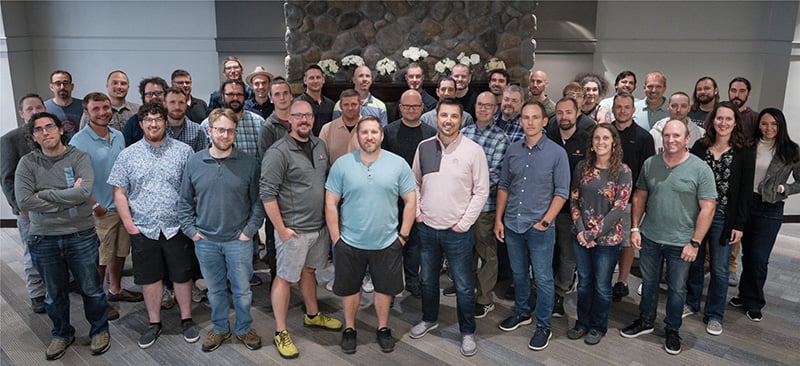Custom software development is essential—it can help any organization meet and exceed its business goals. But how do you go about building a successful software development team that can build custom software for your business? Like anything else, it all starts with learning the basics.
In this article, we’ll guide you through the benefits of hiring outsourced software development and building your own development team. We’ll also address what those teams should look like and how they are structured so you can be sure your team will be successful.
The Benefits of Building a Team vs. Hiring One
When building a successful software development team, you have two options: outsourcing or hiring from the ground up. There are benefits to both options.
Benefits of Hiring an Outsourced Team
- Reduced overall costs: While you might spend more money initially, you won’t have to spend money on recruitment, training, or benefits packages with an outsourced team.
- Quicker turnaround: If you want to expedite the software development process, outsourcing is the way to go. The second you find an idea to develop, you can hire a team to make it a reality.
- Better access to experts: You don’t have to search for experts when you outsource. Hiring a development team is an easy way to gain quick access to industry experts.
- More project flexibility: With an in-house team, you may not utilize every employee on every project. But with outsourcing, you can hire whatever team size your project requires.
Benefits of Building an Internal Team
- Handpicked employees: You don’t always know what you will get with an outsourced team. With an internal development team, you can handpick each employee to better ensure they are dedicated to your vision.
- Total control of your project: While you still maintain a lot of control over your project with an outsourced team, there might be some things that get lost through miscommunication. But when everything’s in-house, you have direct lines to every member of the team.
- No difference in work culture: Maintaining a consistent work culture is incredibly helpful for inspiring productivity. With in-house, you don’t have to worry about a work culture difference getting in the way of that productivity.
- Industry-specific expertise: If you want to develop software for a particular industry, it helps find developers who have a lot of experience in that field. While that can be hard to find in a team, individual developers with certain specialties are much easier to come by.
What Makes a Great Development Team?

Regardless of whether you’re adding to a pre-existing team or building a software development team from scratch, there are best practices you should follow to create the most successful development team possible. Those best practices include:
- The required roles and responsibilities
- The recommended structure of those roles
With that in mind, here’s what you need to know about how to build a software development team. Or, if you plan on outsourcing your team, these are the roles you should make sure the team has.
What Are the Roles and Responsibilities in a Software Development Team?
In any software development team, no matter the size, some essential roles and responsibilities are required—you cannot have a successful team without them. So, let’s go over the seven roles you need on your development team.
1. Product Manager
The product manager is the one with the vision—the person who knows why the custom software should be built in the first place. As such, this lead should have the final say on all decisions about the software’s development.
To effectively operate in this role, a product manager must act in the following capacities:
- Defining criteria for the software
- Communicating customer needs to the development team
- Ensuring the product delivers on their original vision
If you outsource your software development, you would essentially fill this role.
2. Project Manager
While the product manager has the vision of what the software should look like, it is not their job to manage the development. That falls to the project manager—someone who will look over the day-to-day happenings of the development.
To manage software development, project managers must be adept at:
- Scheduling and documenting meetings relevant to the project
- Monitoring the performance of their software developers
- Removing obstacles hindering the team
- Understanding what their team needs to perform wel
While product managers and project managers work closely together to ensure the software reflects the original vision, the project manager will focus much more heavily on the technical aspects of the process.
3. Software Developers
This one is a no-brainer—you need software developers on your software development team. These professionals will be in charge of coding the software solution.
When working with the rest of your development team, software developers will have two primary responsibilities:
- Developing, testing, and deploying software features
- Updating the project manager on the current status of the product
While it’s admirable to find the most skilled and talented developers to join your team, you do not need (nor should you prioritize) a team composed solely of senior-level experts. Hire one or two senior-level developers, depending on the size and scope of your project, and supplement the development team with a few junior or entry-level developers. Your senior-level developer(s) will be well-equipped to manage those lower-level developers.
4. Software Architects
Software architects work with developers to define the essential aspects of the software’s internal structure and technical aspects. These architects will also offer internal tech support for the developers and other members of the development team.
All in all, a software architect will have the following responsibilities:
- Reviewing code to ensure quality
- Overseeing the progress of the software development
- Locating needs and solutions for challenges in the development process
The software architect will essentially operate as one of your software development team leaders, ensuring that development runs smoothly from start to finish.
5. UI/UX Designer
User interface (UI) is the space where a human will interact with a software solution. User experience (UX) is how that human will interact with the interface. While this role is actually two jobs, these variables have enough overlap to cover in the same section.
A UI/UX designer can have any of these responsibilities:
- Identifying user needs and implementing those insights into the software design
- Providing high-quality design assets
- Offering guidance on the implementation of UI/UX techniques
- Testing the design to ensure it resonates with human users
Essentially, UI/UX designers help make your software solution “pop.” Only with these designers can you develop a software solution that is both pleasing to the eye and easy to use on the customer’s side.
6. Quality Assurance Engineers
Quality assurance (QA) engineers are the final touchpoint to affirm a software’s quality. Aside from quality assurance, these engineers also help build the framework of the software development strategy to ensure quality is achievable from the start of the project.
To accomplish this, QA engineers must perform the following tasks:
- Evaluating the software to determine there are no errors and it meets the quality expectations
- Certifying that the development team met the criteria of the task assigned to them
- Detecting and managing defects in the software
QA engineers may just sound like the ones who point out software bugs, but their role goes far beyond that. They must also use their software development knowledge to point out inefficiencies in the programming so the software is as streamlined and functional as can be.
7. Business Analyst
Lastly, business analysts look at your client’s business needs to help inform the development of your product. Generally, the business analyst should work closely with the product manager to ensure that the product’s vision aligns with client needs.
Business analysts will work on the following tasks to ensure their goals are met:
- Establishing key product features
- Ensuring business proceedings don’t disrupt software development
- Acting as a liaison between product managers and project managers
Business analysts should offer creative input during the early stages of development. For example, their knowledge of client needs can help inform developers’ features in the final product.
How Do You Structure a Software Development Team?

While you should structure your software team however you want, it is vital to understand how these roles interact in an ideal scenario. Here’s a basic “chain-of-command” you can use for your development team:
- The product manager and the business analyst work together to develop a software concept that meets the needs of their clients.
- The business analyst communicates these design specifications to the project manager, who will then work with their team to establish design parameters for the project moving forward.
- The project manager works with the software architect(s) to establish a software developers’ framework for coding.
- The software architect works with software developers and UX/UI designers to ensure the product meets design specifications.
- All the while, the quality assurance engineers check with software developers and UX/UI designers to ensure the product meets expectations. They report their findings to the project manager, who reports back to the product manager.
Typically, these roles will all interact with each other. On certain projects, leadership can be composed of product managers, project managers, and an architect. If you want to learn about the finer details of how these roles interact with one another, read our article about the software development process.
Make Your Software Goals a Reality with Emergent Software
If you believe a custom software solution could help you achieve your goals, we encourage you to consider what Emergent Software can do for you. Our custom software development teams are always at the ready to make your vision into reality.
Contact our software professionals today to get started.






